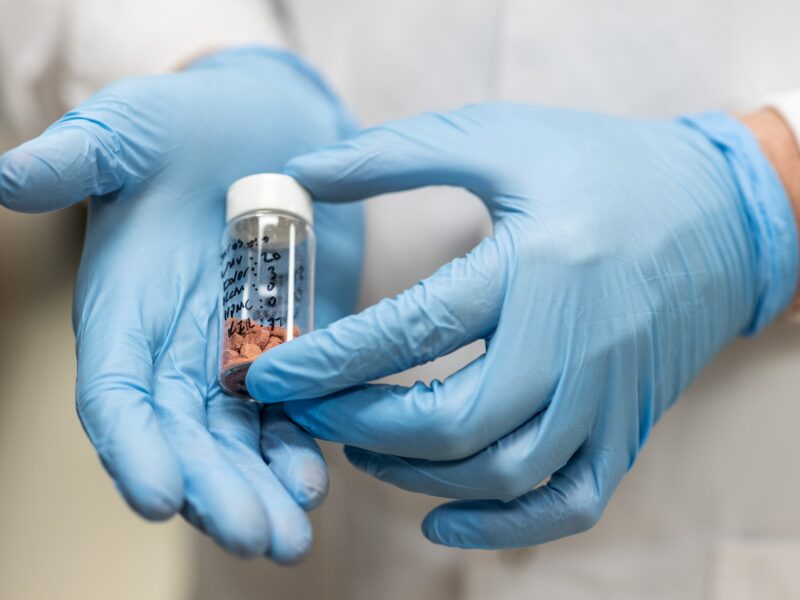What Is Ozempic? Texas A&M Pharmacists Explain Drug Viral On Social Media
Ozempic is generating headlines as celebrities and social media influencers have described taking the diabetes drug to lose weight.
TikToks that detail users’ alleged medication-induced weight loss have racked up hundreds of millions of views, and the increase in demand is so high that the Food and Drug Administration’s database lists the drug’s active ingredient as “currently in shortage.”
Dr. Pooja Patel and Dr. Andrew Tenpas, two clinical assistant professors in the Department of Pharmacy Practice at the Texas A&M University Irma Lerma Rangel School of Pharmacy, explain that drugs like Ozempic (and Wegovy, another popular option) are glucagon-like peptide-1 receptor agonists (GLP-1RAS), a class of medications first introduced in 2005 used primarily for blood sugar control for Type 2 diabetes patients.
As more trial data has been gathered, Tenpas said, the drugs have been increasingly prescribed for weight loss, cardiac and kidney protection, and a type of non-alcoholic steatohepatitis, which is liver inflammation or damage caused by a buildup of fat in the organ. Patel said they’re also a good treatment option for patients with certain cardiovascular diseases.
How do Ozempic and Wegovy work?
Almost all members of this drug class are subcutaneous injections available as either single- or multi-dose pens, with Ozempic and Wegovy dosed as once-weekly injections.
For people with Type 2 diabetes, Patel said, the drugs mimic a hormone called glucagon-like peptide-1. These medications work to help manage blood sugar levels in diabetes patients by helping the body release insulin when needed, keeping the liver from releasing too much sugar into the blood, slowing food from leaving the stomach and reducing blood sugar spikes, and signaling to the body that it feels full.
Are more people expressing interest in these drugs?
“Speaking from personal experience, I have definitely seen a significant increase in recent months in the number of patients asking questions about Ozempic and other GLP-1 drugs,” said Tenpas, an ambulatory care pharmacist at the McAllen VA Outpatient Clinic in McAllen, Texas. “Between television commercials and testimonials all over social media, it’s hard to avoid exposure to this class.”
Patel, who is a clinical pharmacist specialist at the Memorial Hermann Medication Therapy and Wellness Clinic in the Texas Medical Center in Houston, said she’s also seen a “tremendous surge” in demand for the drugs.
“They have a low risk of hypoglycemia and help tremendously with weight loss, so it is an attractive agent that we can utilize for our patients with Type 2 diabetes,” Patel said. “However, there has been a tremendous surge in its demand after people started talking about their weight loss success with GLP-1RAs on social media.”
These drugs aren’t approved for weight loss – is it OK to take medications for off-label uses?
Tenpas said Ozempic and Wegovy are FDA-approved for treatment of Type 2 diabetes, obesity and prevention of cardiovascular disorders, but prescribers may also prescribe them for “off-label” uses including non-alcoholic steatohepatitis.
“Whether patients and prescribers use these medications ‘off-label’ isn’t necessarily my concern, as long as there is a sound medical rationale, they are used responsibly by the patient, and patients are regularly monitored by a prescriber or pharmacist,” he said.
The question of whether medications should used for purposes they haven’t been approved for by the FDA is complex, Patel said. It may take years for a drug to be approved, and available literature may encourage providers to safely initiate a medication for an off-label indication. She said this is why several medications have more than one use
“However, I strongly believe that it is important for healthcare providers to be up-to-date on ongoing research and involve the patient in shared decision-making while weighing the risk vs. benefit for each individual,” Patel said.
How are the drug shortages affecting diabetes patients?
This increased demand and subsequent shortage in Ozempic has impacted many of Tenpas’ patients. Some have been unable to regularly take the medication due to significant gaps or uncertainty over availability, he said. In some cases, pharmacists have reservations about starting qualified patients on the medication at all due to the shortages.
“Many patients are unable to regularly obtain a potentially beneficial medication, which is extremely disappointing for all parties,” he said.
Similarly, Patel has also had several patients report difficulties with obtaining Ozempic – and about 95 percent of the patients she manages are high-risk. Pharmacies either do not have the drugs at all, or only have a particular strength available.
“Unlike other medications where we can tell patients to take more of the lower strength medication to equal their recommended dose, I cannot do that with these GLP-1RAs, as some insurances do not allow that,” Patel said. “This has led to several of my patients being out of the medication for several weeks, using less effective lower doses, or having to switch to less optimal agents to maintain their sugars with their goal range.”
How do healthcare providers monitor patients using Ozempic or Wegovy?
Before someone starts using a GLP-1RA, providers must first ensure the patient doesn’t have a family history of thyroid cancer, pancreatitis or gallbladder disease, Patel said. Once initiated, providers will monitor for common side effects. Patel said they pay attention to blood sugar readings, body weight, kidney function, triglycerides, signs of pancreatitis or gall bladder disease, and worsening of diabetic retinopathy.
When starting Ozempic or Wegovy, Tenpas said it’s advisable for patients to maintain close contact with their prescriber or pharmacist.
“GI upset including nausea, vomiting and diarrhea, weight loss, or dramatically decreased appetite may occur,” he said. “Prescribers and pharmacists can help patients recognize what is normal, what is abnormal – and potentially serious – and how to navigate those side effects.”
At Tenpas’ practice, he follows up with patients who start Ozempic within the first few weeks, when in many cases people experience significant gastrointestinal upset. He said generally speaking, the longer a patient is on a medication, the better it is tolerated, but the risk for side effects is always present whenever a patient starts a higher dose or restarts the medication after a long discontinuation.
Patients who are interested in taking Ozempic or Wegovy should discuss it with their physician, prescriber or pharmacist, Tenpas said.
Since these types of drugs are relatively new, Tenpas encourages interested patients to contact their insurance company to learn more about estimated costs.
Media contact: Shelby Purdy, shelbypurdy@tamu.edu





